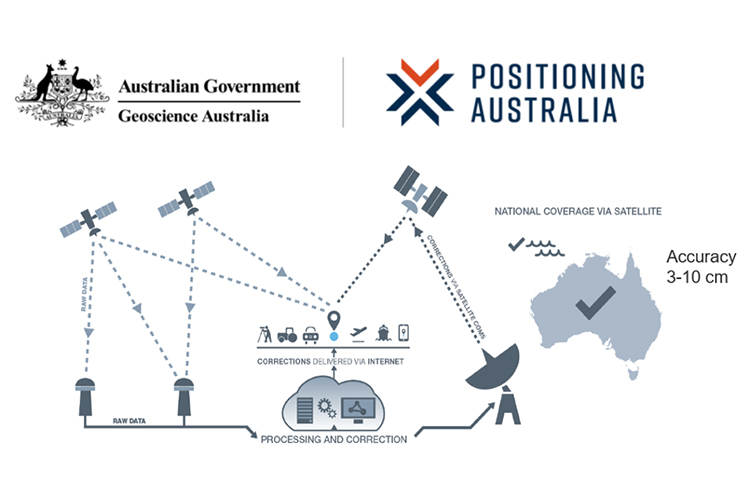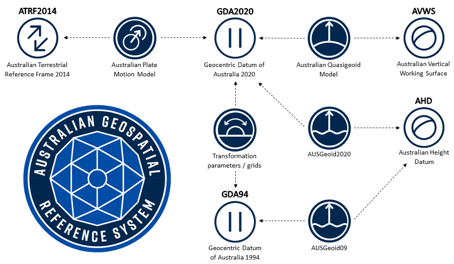Positioning Australia for the future

In 2018, the Australian Commonwealth Government committed AUD $224.9m to the Positioning Australia program to provide 10 centimetre accurate and reliable positioning to all Australians, as well as accelerate the adoption and development of positioning technology and applications. This is a significant improvement from the 5-10 metre accuracy you can currently achieve using consumer positioning devices.
The funding commitment recognises the role geodesy plays in our everyday lives. Geodesy enables us to compute where we are on the Earth, where things are around us and align spatial data to make better decisions.
Geodesy is relied upon for a myriad of social, environmental and economic initiatives. In addition to the traditional survey, mapping and navigation fields, geodetic applications are increasingly critical for a number of industries such as agriculture, transport, emergency management, mining, engineering and logistics.
User challenges
More Australians are adopting positioning technologies and applications every year. By 2023, location-based services and intelligent transport services (road, rail, maritime and aviation) are expected to account for 93.5% of Global Navigation Satellite System (GNSS) chipset sales (GSA, 2015) [1]. Furthermore, the Australian economy is estimated to grow by an additional AUD $73b due to augmented positioning by 2030 (Allen, 2008) [2].
There is a growing number of non-specialist users of location-based and intelligent transport services that expect real-time, accurate, high-integrity positioning services and applications. Typically, these users operate without an understanding of the complexities of coordinate transformations, coordinate conversions, datums and geoid models.
The challenge for governments and spatial professionals is to develop high-quality, robust infrastructure, tools and communication services which will enable industry, scientists and the public to capitalise on this technology.
Through the implementation of the Positioning Australia program, Geoscience Australia is aiming to enhance the access, accuracy and reliability of positioning and accelerate the adoption of positioning technology and applications across a range of industries to accelerate economic growth. This will be done by completing a range of projects described below.
Accurate and reliable positioning for all Australians
To ensure accurate positioning information is widely available to the Australian community, the Positioning Australia is delivering two complementary projects:
- A national network of ground station infrastructure and GNSS analysis software (see below)
- A system to deliver corrected positioning signals directly to Australian’s via satellite technology through a Satellite-Based Augmentation System (SBAS).
- Densification of Global Navigation Satellite System infrastructure
To ensure Geoscience Australia is able to provide high quality positioning corrections across the continent, AUD $64m has been allocated to upgrade and expand Australia’s ground network of Global Navigation Satellite System (GNSS) infrastructure.
A network of approximately 200 government-operated multi-GNSS ground stations will be densified with over 500 third-party ground stations to generate open access, centimetre accurate positioning corrections available over mobile internet (when in a coverage area). Geoscience Australia will also establish a GNSS data centre by June 2022 to monitor the GNSS network, archive and distribute the data and services to users from a variety of different sectors, including system integrator and innovators.
- Delivering corrected positioning signals through a Satellite-Based Augmentation System (SBAS)
A SBAS overcomes current gaps in mobile and radio communications and, when combined with our national infrastructure network, ensures that accurate positioning information can be received. SBAS augments and corrects GNSS signals to improve the accuracy of positioning data and makes it available across Australia and its maritime zones without the need for mobile phone or internet coverage.
In February 2020, Australia and New Zealand entered into a partnership to jointly deliver the SBAS component of the program. This will be the first such system in the Southern Hemisphere and will be called the Southern Positioning Augmentation Network.
Current technology typically allows for positioning within 5-10 metre accuracy, but through this program, accuracy will be improved to within three centimetres in areas with mobile phone coverage and ten centimetres everywhere else. This will deliver accurate, reliable and instantaneous positioning across Australia and its maritime zones (Figure 1 – Feature image below). Together, these will provide more reliable positioning information, allowing for innovation and efficiency across a range of industries.
Development of open source real-time positioning software and products
To encourage uptake and innovation of Positioning Australia’s accurate and reliable positioning, navigation and timing services, Geoscience Australia is developing and releasing multi-GNSS analysis software that is capable of managing the acquisition, processing and delivery of multi-GNSS data and related products.
This capability will comprise of the following components:
- Network Platform: which accepts carrier, code and ranging observation data to enable the computation of high accuracy orbits, clocks, satellite phase biases and atmospheric models as well as station coordinates.
- User Platform: which accepts high accuracy orbits, clocks, satellite phase biases and atmospheric models in addition to carrier and code observation data to enable single-receiver users to compute high accuracy positions.
- Combination Platform: which accepts parameter estimates and their variance-covariance information to enable the combination of geodetic solutions. This includes combining station coordinates into multi-day solutions, station coordinates into multi-year solutions with the estimation of station velocities, and time series analysis.
The first version of the software was delivered in June 2018. Geoscience Australia will continue the subsequent software development and anticipates having a suite of open source software capable of processing satellite data and delivering high accuracy and real time positioning data by June 2022.
Upgrading the Australian Geospatial Reference System
The Australian Geospatial Reference System is a collective term used to describe the datums, reference frames, models, infrastructure and standards needed for accurate and reliable 4D positioning.
To maximise the benefits of the emerging precise positioning technology, users require datums or reference frames which are more accurate than the data – these should be closely aligned to reference frames of GNSS and in some cases, time-dependent.
In anticipation, over the past decade, geodetic scientists from Australia’s Commonwealth, state and territory governments have upgraded of a number of elements of Australia’s Geospatial Reference System including upgrading the static datum (from Geocentric Datum of Australia 1994 (GDA94) to Geocentric Datum of Australia 2020 (GDA2020)). Australia has also introduced a time-dependent reference frame – Australian Terrestrial Reference Frame 2014 (ATRF2014) – which is a densified version of the International Terrestrial Reference Frame 2014 (ICSM, 2020) [3]. Users are able to propagate between the static GDA2020 and time-dependent ATRF2014 using a plate motion model.
Other upgrades to the Australian Geospatial Reference System include:
- A new reference surface for heights – Australian Vertical Working Surface
- The development of standards to improve access and efficiency of geodetic data (e.g. GeodesyML [4]).
For more information on aspects of the upgrade, please refer to the Intergovernmental Committee on Surveying and Mapping website [5].
Our role as spatial professionals
Overall, user expectations and technological improvements continue to drive down the uncertainty of positioning data. This in turn highlights the requirement to continually improve the accuracy and integrity of our data and datums. This is a new era for the geodetic community—more people than ever are reliant on the work we do, but just as many do not understand it. This is not to say they should understand it – in fact, they should be abstracted from it by spatial professionals.
It is our role, as these spatial professionals, to improve the technology, understand the user requirements, and meet the user expectations.

Figure 2: The Australian Geospatial Reference System is the collective term used to describe the datums, reference frames, models, infrastructure and standards needed for accurate and reliable 4D positioning.
Sources:
- https://www.gsa.europa.eu/system/files/reports/GNSS-Market-Report-2015-issue4_0.pdf
- Economic benefits of high resolution positioning services (https://www.crcsi.com.au/assets/Resources/ffa927a7-55d1-400a-b7d6-9234f4fe4ad2.pdf)
- https://www.icsm.gov.au/sites/default/files/2020-02/ATRF%20Technical%20Implementation%20Plan%20v2.3_1.pdf
- www.geodesyml.org
- https://www.icsm.gov.au/australian-geospatial-reference-system
Related Articles
Here are more related articles you may be interested in.







